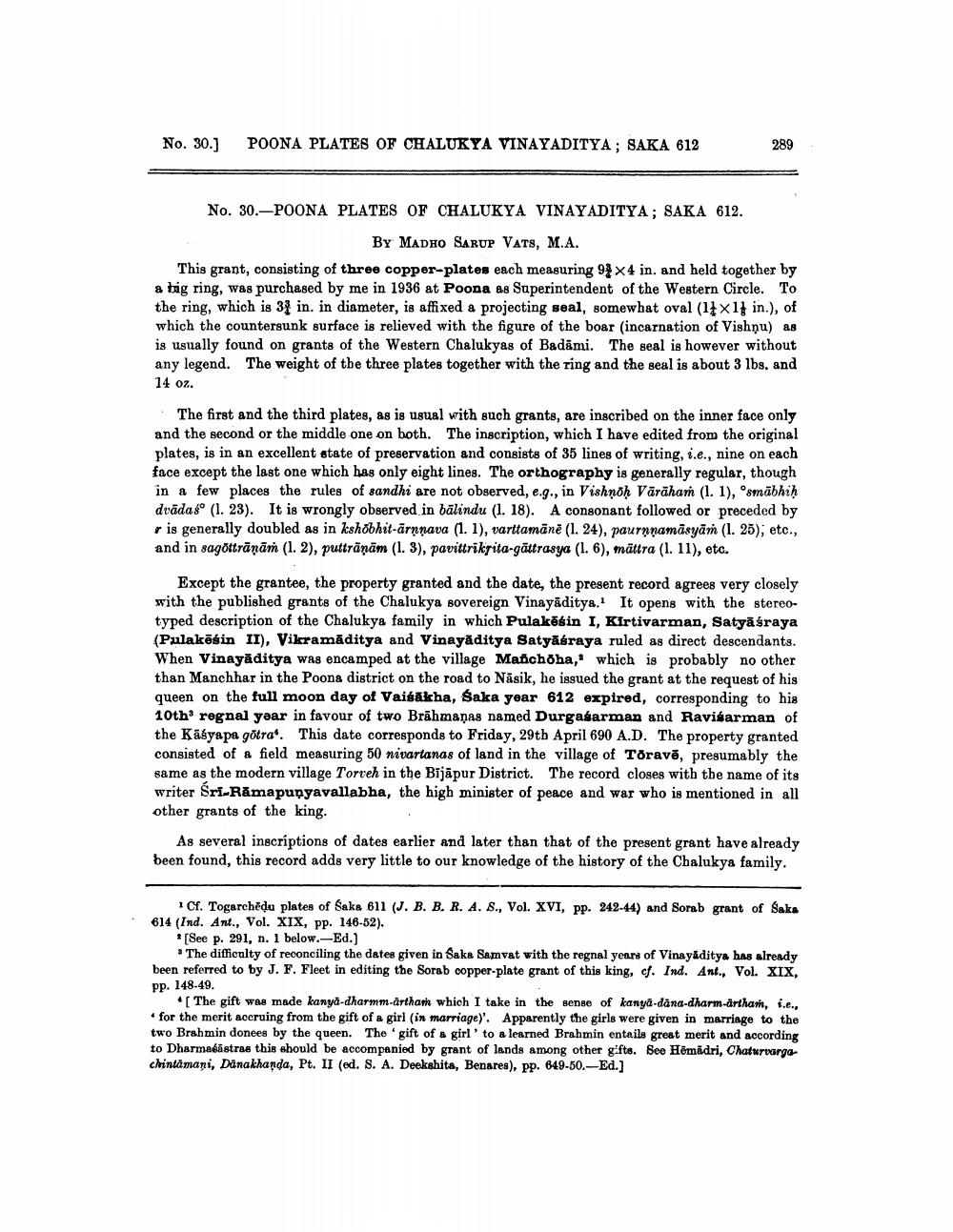________________
No. 30.)
POONA PLATES OF CHALUKYA VINAYADITYA; SAKA 612
289
No. 30.-POONA PLATES OF CHALUKYA VINAYADITYA; SAKA 612.
BY MADHO SARUP VATS, M.A. This grant, consisting of three copper-plates each measuring 97 x 4 in, and held together by a big ring, was purchased by me in 1936 at Poona as Superintendent of the Western Circle. To the ring, which is 34 in. in diameter, is affixed a projecting seal, somewhat oval (14x11 in.), of which the countersunk surface is relieved with the figure of the boar (incarnation of Vishņu) as is usually found on grants of the Western Chalukyas of Badāmi. The seal is however without any legend. The weight of the three plates together with the ring and the seal is about 3 lbs, and 14 07.
The first and the third plates, as is usual with such grants, are inscribed on the inner face only and the second or the middle one on both. The inscription, which I have edited from the original plates, is in an excellent state of preservation and consists of 35 lines of writing, i.e., nine on each face except the last one which has only eight lines. The orthography is generally regular, though in a few places the rules of sandhi are not observed, e.g., in Vishnoh Vārāham (1.1), Osmābhiḥ dvāda t° (1. 23). It is wrongly observed in bālindu (1. 18). A consonant followed or preceded by r is generally doubled as in kshobhit-ārnnava (1.1), varttamānė (1. 24), paurnnamāsyāṁ (1. 25), etc., and in sagöttränāṁ (1.2), puttrāņām (1. 3), pavittrikrita-gāttrasya (1. 6), mättra (1. 11), etc.
Except the grantee, the property granted and the date, the present record agrees very closely with the published grants of the Chalukya sovereign Vinayāditya. It opens with the stereotyped description of the Chalukya family in which Pulakësin I, Kirtivarman, Satyasraya (Pulakēgin II), Vikramaditya and Vinayāditya Satyā raya ruled as direct descendants. When Vinayaditya was encamped at the village Mañchoha,' which is probably no other than Manchhar in the Poona district on the road to Näsik, he issued the grant at the request of his queen on the full moon day of Vaisakha, Saka year 612 expired, corresponding to his 10th regnal year in favour of two Brāhmaṇas named Durgabarman and Ravisarman of the Kāśyapa götral. This date corresponds to Friday, 29th April 690 A.D. The property granted consisted of a field measuring 50 nivartanas of land in the village of Toravē, presumably the same as the modern village Torreh in the Bijāpur District. The record closes with the name of its writer Sri-Rămapunyavallabha, the high minister of peace and war who is mentioned in all other grants of the king.
As several inscriptions of dates earlier and later than that of the present grant have already been found, this record adds very little to our knowledge of the history of the Chalukya family.
1 Cf. Togarchēdu plates of Saka 611 (J. B. B. R. A. S., Vol. XVI, pp. 242-44) and Sorab grant of Saka 614 (Ind. Ant., Vol. XIX, pp. 146-52).
*[See p. 291, n. 1 below.-Ed.)
* The difficulty of reconciling the dates given in Saka Samvat with the regnal years of Vinayaditya has already been referred to by J. F. Fleet in editing the Sorab copper-plate grant of this king, cf. Ind. Ant., Vol. XIX, pp. 148-49.
The gift was made kanya-dharmm-artham which I take in the sense of kanya-dana-dharm-arthan, i.e., . for the merit accruing from the gift of a girl (in marriage)'. Apparently the girls were given in marriage to the two Brahmin donees by the queen. The gift of a girl' to a learned Brahmin entails great merit and according to Dharmalistras this should be accompanied by grant of lands among other gifts. See Hémadri, Chaturvarga chintamani, Danakhanda, Pt. II (ed. S. A. Deekshita, Benares), pp. 649-50.-Ed.]




